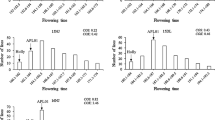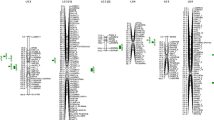Abstract
Ramie is an important fiber and forage crop in China. Breeding of late- or non-flowering varieties with higher vegetative yields is an important goal because this high yield is required for ramie production for both fiber and feed use. However, the genetic basis for the flowering time trait is poorly understood, and this has severely hindered the improvement of this trait in ramie breeding. In our previous study, a genetic linkage map has been constructed based on an F2 agamous line (FAL) population derived from two parents, Qingyezhuma and Zhongzhu 1. In this study, four traits, i.e., days from sprouting to the appearance of male flower buds (DSAMB), days from sprouting to male flowering (DSMF), days from sprouting to the appearance of female flower buds, and days from sprouting to female flowering (DSFF), were investigated in this FAL population. Significant difference between two parents and large variation in FALs was observed for these four traits. The analysis of quantitative trait locus (QTL) for these four flowering time traits was performed in ramie for the first time. Finally, a total of 7, 5, 10, and 7 QTLs for DSAMB, DSMF, DSAFB, and DSFF, respectively, were identified in the FAL population in 2 years. Of these 29 QTLs, 15 were detected in both years, and 16 QTLs exhibited overdominance. Moreover, 11 QTL clusters were identified. The identification of these QTLs will be helpful for molecular designing of the flowering time traits in ramie breeding programs by marker-assisted selection.


Similar content being viewed by others
References
Byrne S, Guiney E, Barth S, Donnison I, Mur LA, Milbourne D (2009) Identification of coincident QTL for days to heading, spike length and spikelets per spike in Lolium perenne L. Euphytica 166:61–70
Cuesta-Marcos A, Igartua E, Ciudad F, Codesal P, Russell J, Molina-Cano J, Moralejo M, Szucs P, Gracia M, Lasa J, Casas A (2008) Heading date QTL in a spring × winter barley cross evaluated in Mediterranean environments. Mol Breed 21:455–471
Doi K, Izawa T, Fuse T, Yamanouchi U, Kubo T, Shimatani Z, Yano M, Yoshimura A (2004) Ehd1, a B-type response regulator in rice, confers short-day promotion of flowering and controls FT-like gene expression independently of Hd1. Genes Dev 18:926–936
Imaizumi T (2010) Arabidopsis circadian clock and photoperiodism: time to think about location. Curr Opin Plant Biol 13:83–89
Kojima S, Takahashi Y, Kobayashi Y, Monna L, Sasaki T, Araki T, Yano M (2002) Hd3a, a rice orthology of the arabidopsis FT gene, promotes transition to flowering downstream of Hd1 under short-day conditions. Plant Cell Physiol 43:1096–1105
Kovi M, Sablok G, Bai X, Wendell M, Rognli O, Yu H, Xing Y (2013) Expression patterns of photoperiod and temperature regulated heading date genes in Oryza sativa. Comput Biol Chem 45:36–41
Lincoln SE, Daly MJ, Lander ES (1993) Mapping genes controlling quantitative traits with MAPMAKER/QTL1.1: a tutorial and reference manual, 2nd edn. Whitehead Institute Technical Report, Cambridge
Liu T, Zhang Y, Zhang H, Xing Y (2011a) Quantitative trait loci for the number of grains per panicle dependent on or independent of heading date in rice (Oryza sativa L.). Breed Sci 61:142–150
Liu T, Tang Q, Zhu S, Tang S (2011b) Analysis of climatic factors causing yield difference in ramie among different eco-regions of Yalley valley. Agric Sci Technol 12:745–750
Liu T, Liu H, Zhang H, Xing Y (2013a) Validation and characterization of Ghd7.1, a major QTL with pleiotropic effects on spikelets per panicle, plant height, and heading date in rice (Oryza sativa L.). J Integr Plant Biol 55:917–927
Liu T, Zhu S, Tang Q, Chen P, Yu Y, Tang S (2013b) De novo assembly and characterization of transcriptome using Illumina paired-end sequencing and identification of CesA gene in ramie (Boehmeria nivea L. Gaud). BMC Genomic 14:125
Liu T, Zhu S, Fu L, Tang Q, Yu Y, Chen P, Luan M, Wang C, Tang S (2013c) Development and characterization of 1827 expressed sequence tag-derived simple sequence repeat markers in ramie (Boehmeria nivea L. Gaud). PLoS ONE 8:e60346
Liu T, Zhu S, Tang Q, Tang S (2014) QTL mapping for fiber yield-related traits by constructing the first genetic linkage map in ramie (Boehmeria nivea L. Gaud). Mol Breed 34:883–892
Liu T, Zhu S, Tang Q, Tang S (2015) Identification of a CONSTANS homologous gene with distinct diurnal expression patterns in varied photoperiods in ramie (Boehmeria nivea L. Gaud). Gene 560:63–70
Lou P, Zhao J, Kim J, Shen S, Carpio D, Song X, Jin M, Vreugdenhil D, Wang X, Koornneef M et al (2007) Quantitative trait loci for flowering time and morphological traits in multiple populations of Brassica rapa. J Exp Bot 58:4005–4016
Salvi S, Castelletti S, Tuberosa R (2009) An updated consensus map for flowering time QTLs in maize. Maydica 54:501–512
Sourdille P, Snape J, Cadalen T, Charmet G, Nakata N, Bernard S, Bernard M (2000) Detection of QTLs for heading time and photoperiod response in wheat using a doubled-haploid population. Genome 43:487–494
Squibb R, Méndez J, Guzmàn M, Scrimshaw N (1954) Ramie—a high protein forage crop for tropical areas. Grass Forage Sci 9:313–322
Takahashi Y, Shomura A, Sasaki T, Yano M (2001) Hd6, a rice quantitative trait locus involved in photoperiod sensitivity, encodes the α subunit of protein kinase CK2. Proc Natl Acad Sci USA 98:7922–7927
Tsuji H, Taoka K, Shimamoto K (2011) Regulation of flowering in rice: two florigen genes, a complex gene network, and natural variation. Curr Opin Plant Biol 14:45–52
Turck F, Fornara F, Coupland G (2008) Regulation and identity of florigen: FLOWERING LOCUS T moves center stage. Annu Rev Plant Biol 59:573–594
Wang S, Basten C and Zeng Z (2012) Windows QTL Cartographer 2.5. Department of Statistics, North Carolina State University, Raleigh. http://statgen.ncsu.edu/qtlcart/WQTLCart.htm
Xiong H, Yu C, Wang Y, Tang S, Guo Y, Zhu A (2005) Study on selection and breeding of new feed ramie variety Zhongsizhu no.1. Plant Fibers Prod 27:1–4 (in Chinese, with English abstract)
Xue W, Xing Y, Weng X, Zhao Y, Tang W, Wang L, Zhou H, Yu S, Xu C, Li X, Zhang Q (2008) Natural variation in Ghd7 is an important regulator of heading date and yield potential in rice. Nat Genet 40:761–767
Yan W, Wang P, Chen H, Zhou H, Li Q, Wang C, Ding Z, Zhang Y, Yu S, Xing Y (2011) A major QTL, Ghd8, plays pleiotropic roles in regulating grain productivity, plant height, and heading date in rice. Mol Plant 4:319–330
Yan W, Liu H, Zhou X, Li Q, Zhang J, Lu L, Liu T, Liu H, Zhang C, Zhang Z et al (2013) Natural variation in Ghd7.1 plays an important role in grain yield and adaptation in rice. Cell Res 23:969–971
Yano M, Harushima Y, Nagamura Y, Kurata N, Minobe Y, Sasaki T (1997) Identification of quantitative trait loci controlling HD in rice using a high-density linkage map. Theor Appl Genet 95:1025–1032
Yano M, Katayose Y, Ashikari M, Yamanouchi U, Monna L, Fuse T, Baba T, Yamamoto K, Umehara Y, Nagamura Y et al (2000) Hd1, a major photoperiod sensitivity quantitative trait locus in rice, is closely related to the Arabidopsis flowering time gene CONSTANS. Plant Cell 12:2473–2484
Acknowledgments
This work was supported by grants from the National Natural Science Foundation of China (31571725), the Agricultural Science and Technology Innovation Program of China (ASTIP), and the National Modern Agro-industry Technology Research System of China (nycytx-19-E16).
Author information
Authors and Affiliations
Corresponding authors
Rights and permissions
About this article
Cite this article
Zhu, S., Zheng, X., Dai, Q. et al. Identification of quantitative trait loci for flowering time traits in ramie (Boehmeria nivea L. Gaud). Euphytica 210, 367–374 (2016). https://doi.org/10.1007/s10681-016-1692-4
Received:
Accepted:
Published:
Issue Date:
DOI: https://doi.org/10.1007/s10681-016-1692-4




